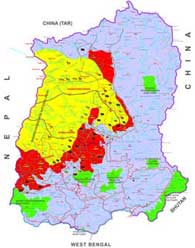Wildlife
Sikkim State Symbols

Latest News on Wildlife 
» Camera traps click Tiger at 13,011 ft (National Record), Bison at 11,706 ft (World Record) in Sikkim
» Public Notice on Prohibition of Feeding Monkeys. Violators to be fined Rs 5000/- (August 19, 2023)
» Blue Duke (Bassarona durga) declared as State Butterfly of Sikkim (June 5, 2022)
» Copper Mahseer (locally known as 'Katley') declared as State Fish of Sikkim (Gazette date 02/09/2021)
» Sikkim hosted National Workshop on "Challenges for Biodiversity Conservation and Human-wildlife Conflict - Identifying the problems and possible solution"
» Ban on use of recorded bird calls/ song playback in WPAs of Sikkim (Notification dated 16/04/2019)
» Snow Leopard sighted by camera trap in Sikkim
» Royal Bengal Tiger sighted by camera trap in Sikkim
» Khangchendzonga Biosphere Reserve (KBR) has been added to UNESCO's list of World Network of Biosphere Reserve
» Significant findings in Wildlife Survey (Out of 262 camera traps, 189 locations spot 37 species)
» Human Wildlife Conflict in Sikkim
» State-wide estimation of Widlife Population underway in Sikkim | » See reports (1st and 2nd Phase)
» Widlife Week (Oct 2-8) Celebrated
» Khangchendzonga National Park inscribed into the UNESCo's World Heritage Site
» Guidelines for Dispensing Compensation for Life, Property Losses during Human Wildlife Conflict - Sikkim 
» Management Plan of Khangchendzonga National Park (Updated 2014)
» Declaration of Eco-Sensitive Zones in Sikkim
» Environment Clearance of Development Projects in Sikkim
Protected Areas
India has at present four categories of protected area (PAs), these are National Parks, Sanctuaries, Conservation Reserves and Community Reserves which are provided legal sanctity by the Wildlife (Protection) Act 1972. However, there are six categories specified by the IUCN (International Union for Conservation of Nature) and different countries have different categories of PAs as per their requirements and norms laid by their Governments.
Current Figure of Protected Areas in India ( As on December 2021) 
Geographical Area of India = 32,87,263 km2 (Source: http://knowindia.gov.in)
India has a network of 987 Protected Areas extending over 1,73,053.69 km2 (5.26 % of total geographic area), comprising 106 National Parks, 564 Wildlife Sanctuaries, 99 Conservation Reserves and 218 Community Reserves. UNESCO has designated 6 Protected Areas as World Heritage Sites. Read More on WII ENVIS Website
Source: WII, Dehradun
|

Click on the Map to view
|
Wildlife Protected Areas of Sikkim
In Sikkim we have, presently, 9 Protected Areas which comprises of 1 National Park, 7 Wildlife Sanctuaries and 1 conservation Reserve that covers 30.77 per cent of the total geographical area of the state.
| SN |
Name |
Area (sq. km) |
District |
Bio-geographic Province |
Altitude (m) |
Notification No. & Date |
Co-ordinates |
| Long (East) |
Lat (North) |
| |
National Park
|
| 1 |
Khangchendzonga National Park
(World Heritage Site - declared on 17/07/2016)
|
1784.00 |
North/ West |
1 B & 2 C |
1400 - 8585 |
95/KNP dt: 26.08.07 |
88º 03' to 88º 39' |
27º 27' to 27º 53' |
| |
Wildlife Sanctuaries |
| 1 |
Barsey Rhododendron Sanctuary |
104.00 |
West |
2 C |
2110 - 4100 |
50/WL/F/95/269/F & WL dt: 08.06.96 |
88º 02' to 88 11' |
27º 10' to 27 13' |
| 2 |
Fambonglho Wildlife Sanctuary |
51.76 |
East |
2 C |
1524 - 2749 |
34/WL/82 dt: 02.04.84 |
88º 29' to 88º 35' |
27º 10' to 27º 23' |
| 3 |
Kyongnosla Alpine Sanctuary |
31.00 |
East |
2 C |
3292 - 4116 |
45/WL/83/625 dt: 29.08.84 Extended vide 45/WL/F/92/1585/F & WL dt: 05.12.1992 |
88º 44' to 88º 45' |
27º 22' to 27º 24' |
| 4 |
Maenam Wildlife Sanctuary |
35.34 |
South |
2 C |
2000 - 3263 |
63/WL//F/86 dt: 09.03.87 |
88º 21' to 88º 25' |
27º 21' to 27º 25' |
| 5 |
Pangolakha Wildlife Sanctuary |
128.00 |
East |
2 C |
1760 - 4390 |
26/WL/F/89 dt: 07.11.00 |
88º 35' to 88º 51' |
27º 09' to 27º 22' |
| 6 |
Shingba Rhododendron Sanctuary |
43.00 |
North |
2 C |
3048 - 4575 |
46/WL/F/92/1585/F&WL dt: 05.12.92 |
88º 43' to 88º 46' |
27 43' to 27 48' |
| 7 |
Kitam Bird Sanctuary |
6.00 |
South |
|
320 - 875 |
39/FEWM/2005 dt: 03.02.05 |
88º 20' to 88º 22' |
27º 06' to 27º 07 |
| |
Conservation Reserve |
| 1 |
Sling Dong Fairrieanum
Orchid Conservation
Reserve |
0.60 |
South |
|
|
Not. No. 24/CWLW/GOS/
FEWMD/308/WLC/08 dated
05-11-2008 |
|
|
| |
Total area (A) |
2183.70 |
|
- |
- |
- |
- |
- |
| |
KNP Buffer zone |
835.92 |
North/ West |
- |
- |
- |
- |
- |
| |
KNP Transition Zone |
311.20 |
North/ West |
- |
- |
- |
- |
- |
| |
Khangchendzonga Biosphere Reserve (KNP+Buffer+Transition =1784+836)
(KBR listed in UNESCO's list of World World Network of Biosphere Reserve on July 2018)
|
2931.12 |
North/ West |
1 B & 2 C |
2725 - 5537 |
1/KNP/WL/27 dt: 17.05.1997 |
88º 27' to 88º 33' |
27º 33' to 27º 40' |
| |
Total Geographic area ( Sikkim) |
7096.00 |
- |
- |
- |
- |
- |
- |
Note:
1. Protected Area Network including KBR = 3330.28 Sq Km i.e 46.93% of States Geographical Area.
2. Total area under administration by Forests, Environment & Wildlife Management Department
(RF i/c PAs) + Khasmals + Gaucharan =5452+285+104=5841 Sq km)
3. Territorial Sector [RF + Khasmals + Gaucharan = 3268.90 + 285 +104 = 3657.90 Sq. km] i.e. 51.55% of State's Geographical area
4. Wildlife Sector [KNP + Sanctuaries + Conservation Reserve = 2183.70 Sq. km] i.e. 30.77 % of State's Geographical Area.
Declaration of Eco-Sensitive Zones in Sikkim 
In order to conserve and protect the area around the Protected Areas of the State, and to propagate the improvement and development of the wildlife therein and to prohibit industries, operations or processes around the boundary of 8 PAs of the State, the Central Government in consultation with Ministry of Environment, Forests and Climate Change (MoEFCC) has declared certain areas around the 8 PAs of the State as Eco-Sensitives zones through Notification mentioned below;
- Notification# S. O. 2166 dated 27th August 2014, notifies an area up to 200 meters around the boundary of the Khangchendzonga National Park as the Eco-sensitive Zone. The draft of the Notification was published on 3rd February 2014.
- Notification# S. O. 2167 dated 27th August 2014, notifies an area up to 25 meters around the boundary of the Kitam Bird Sanctuary as the Eco-sensitive Zone. The draft of the Notification was published on 25th February 2014.
- Notification# S. O. 2168 dated 27th August 2014, notifies an area up to 200 meters around the boundary of the Kyongnosla Alpine Sanctuary as the Eco-sensitive Zone. The draft of the Notification was published on 4th February 2014.
- Notification# S. O. 2169 dated 27th August 2014, notifies an area up to 50 meters around the boundary of the Shingba Rhododendron Sanctuary as the Eco-sensitive Zone. The draft of the Notification was published on 6th February 2014.
- Notification# S. O. 2170 dated 27th August 2014, notifies an area up to 50 meters around the boundary of the Maenam Wildlife Sanctuary as the Eco-sensitive Zone. The draft of the Notification was published on 25th February 2014.
- Notification# S. O. 2171 dated 27th August 2014, notifies an area up to 25 meters around the boundary of the Fambonglho Wildlife Sanctuary as the Eco-sensitive Zone. The draft of the Notification was published on 4th February 2014.
- Notification# S. O. 2172 dated 27th August 2014, notifies an area up to 50 meters around the boundary of the Barsey Rhododendron Sanctuary as the Eco-sensitive Zone. The draft of the Notification was published on 25th February 2014.
- Notification# S. O. 2173 dated 27th August 2014, notifies an area up to 50 meters around the boundary of the Pangolakha Wildlife Sanctuary as the Eco-sensitive Zone. The draft of the Notification was published on 6th February 2014.
Conservation Zones
Prespective Management Strategies of WPAs of Sikkim
The term wildlife encompasses all uncultivated flora and undomesticated fauna. Every species has the right to live and every threatened species must be protected to prevent extinction. Water, wilderness and wildlife are irrevocably interlinked. With mounting industrial and demographic pressures, wilderness areas, which are the richest repositories of wildlife and biodiversity have either shrunk or disappeared their continued existence is crucial for the long term survival of the biodiversity and the ecosystems supporting them. Effective ecosystem conservation is the foundation of long-term ecological and economic stability. Conservation of biodiversity is directly linked with conservation of ecosystems and thus with water and food security. Habitat loss caused by developmental infrastructural developmental projects for short term economic gains undermining ecological security. Read More
Sikkim Himalayan Zoological Park
Situated in the magnificence of Gangtok’s picturesque hill crest, Bulbulay, at altitudes ranging between 6,545-8,152 feet, the Himalayan Zoological Park sprawls over the expanse of a lush virgin forest reserve with an impressive total area of 230 hectares overlooking the majestic beauty of the Khangchendzonga range. It’s varied terrain ranging from steep rocky surfaces to gentle grassy slopes complemented by varying types of foliage offers congenial natural surroundings for many of Sikkim’s indigenous species, hence providing a comfortable and close to nature environment for the inmates to stay immersed in the wild.
Read more on http://gangtokzoo.org
Read more about Khangchendzonga National Park http://www.knpsikkim.in
|